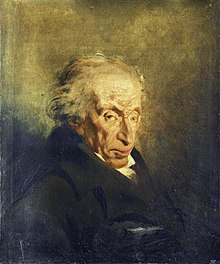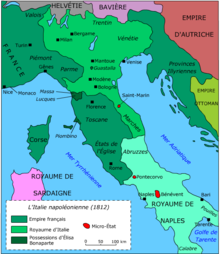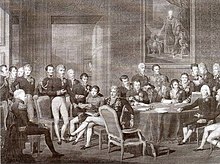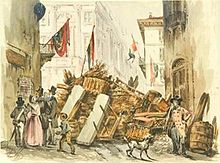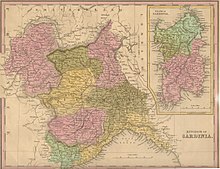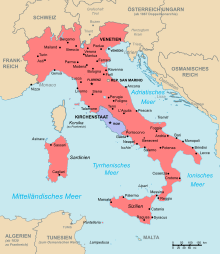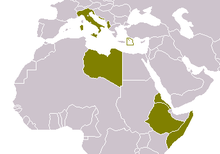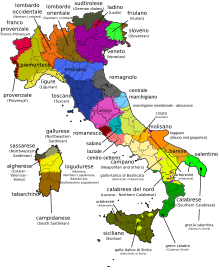Risorgimento
As Risorgimento ( Italian "resurrection") is an era of Italian history from 1815 to 1870, respectively. It is also understood to be ideologically very heterogeneous , political and social movements that, after the Vienna Congress of 1814/15 , sought to unite the then independent principalities and regions of the Apennine Peninsula into an independent nation-state of Italy . This state was enforced after several revolutionary upheavals and the Italian Wars of Independence with the proclamation of the Kingdom of Italy as a constitutional monarchy in 1861 and in 1870 with the military occupation of the papal state (essentially the Lazio region ) and its capital Rome by Italian troops completed for now.
Historical classification, interest groups
In research, the epoch of the Risorgimento is also defined more broadly by some historians such as Werner Daum . These begin the Italian unification movement with the republican- Jacobin uprisings inspired by the French Revolution of 1789 and the short-term foundations of republic after Napoleon Bonaparte's first military successes in some Italian regions from 1796 (see subsidiary republic ). In correspondingly broader historical interpretations, the Risorgimento only became known in 1915 - when Italy entered the First World War - or in 1919 after the end of the war and the incorporation of the so-called Terre irredente (Italian for "unredeemed territories"), which until then still belonged to Austria-Hungary Northern Italy considered closed.
In relation to the pan-European context, the Risorgimento was part of the nation-state independence and unity movements originally oriented towards classical liberalism , which were directed in large parts of Europe from 1815 onwards against the repressive restoration policy of the states of the Holy Alliance . These movements were initially - in the first half of the 19th century - inspired by the ideals of the French Revolution, in particular the civil liberties, which were formulated in the Declaration of Human and Citizens' Rights in 1789 and which Napoléon Bonaparte had spread across Europe with the Civil Code .
In the socio-economic field, the Risorgimento as an epochal term went hand in hand with the fundamental social and economic upheavals of the Industrial Revolution , which began in England in the middle of the 18th century and which also encompassed continental Europe in the course of the 19th century. However, like most of the Mediterranean region , Italy was still dominated by agriculture for a long time . Around the 1860s, the country was not affected by any notable industrialization - especially in northern Italy - whereas the south was dominated by agriculture for a long time and pervaded by structures similar to feudalism . At the same time, the Italian states were also affected by the economic innovations in Europe , particularly with regard to foreign trade , financial policy and pricing for exported handicrafts and, above all, agricultural products. However, this is subject to the limitation that mainly southern Italian regions primarily self-sufficient and inward-looking wirtschafteten and initially less export - or dependent on imports were bound to the international market.
The Risorgimento was supported by interest groups with different ideological orientations. The targets ranged from the establishment of a constitutional Italian monarchy (mainly driven by the Group of Moderati = moderate liberals and so-called Liberal Conservatives) to the creation of a democratic republic (mainly represented by the by the radical liberals to the early socialists extending Parliamentary groups of democratici = democrats ). Despite their sometimes fierce political controversy , all these currents had one idea in common: one that had grown stronger in most European states since the French Revolution, and was essentially supported by the initially liberal-revolutionary bourgeoisie of a then progressive, more or less pronounced nationalism .
Several uprisings were directed against the predominance of the Bourbons in the Kingdom of the Two Sicilies and the Habsburg Austrians in northern and central Italy. These elevations extended to revolutions and wars , whereupon the Italian unity in 1861 under the leadership of Sardinia-Piedmont was finally enforced "from above" - as a constitutional monarchy with the hereditary royal throne of the House of Savoy . The preliminary conclusion of the territorial state formation took place in 1870 with the capture of Rome and of the after 1860 to the Lazio limited Papal States by Italian troops.
“The Risorgimento was never able to win an ideological mass base. The idea of the necessity [...] of the nation state remains limited to the educated and wealthy classes [...]. The overwhelming majority of Italians, especially in the country and most of all in the south, are uncomprehending or even hostile to [these ideas]. "
Late 18th century to 1815
Already at the end of the 18th century there had been efforts to "restore" Italian unity, which of course had ceased to exist since the fall of the Ostrogothic empire in the 6th century. The states and principalities of the Apennine Peninsula had been a political plaything of the major European powers at least since the 16th century with the beginning of the Italian Wars and the decline of the powerful Italian city-states at the end of the Renaissance .
During the years of the French Revolution (1789 to 1799), under the influence of the first French Republic proclaimed in 1792, Italian Jacobins came together in patriotic groups. In Turin , Naples , Palermo and other regions, these groups were the first to attempt to implement the demand for an indivisible Italian republic through - ultimately unsuccessful - uprisings.
Starting in northern Italy in particular, it was Filippo Buonarroti , who was influenced by early socialist ideas , who sought an Italian unification on a social revolutionary basis early on . Originally from Pisa in Tuscany , he had campaigned for the ideas of the French Revolution from the start, had to withdraw from Italy and had himself participated in the revolutionary upheavals in France. As revolutionary commissioner for the Oneglia area occupied in Piedmont , Buonarroti tried in 1794/95 to transfer the revolutionary changes in France to Italian conditions. Because of intrigues against him, he was recalled to Paris, where he was sentenced to prison. In prison he met the French revolutionary Gracchus Babeuf and joined his Conspiracy of Equals (Conjuration des Égaux) a few months after his pardon.
In March 1796 Buonarroti went again to Northern Italy, where he tried through conspiratorial activities to win important personalities of the French army in Italy, among them the new Commander-in-Chief Napoleon Bonaparte , for an Italian unification. Buonarroti's supporters managed to establish a revolutionary Jacobean rule in the Piedmontese city of Alba for a few weeks . In addition, they tried to mobilize other revolutionary forces in Piedmont and Lombardy .
As a representative of the conspiracy of equals , Buonarroti developed plans to change agrarian conditions in France and Italy. He advocated the abolition of private land ownership. With his agricultural policy, Buonarroti wanted to bind the masses of landless peasants to the “equals”. However, he did not succeed in implementing his far-reaching social-revolutionary projects, as both the mass of small farmers and the Italian Jacobins refused to support him on decisive points. Ultimately, all Jacobin attempts to transfer the radical changes of the first years of the revolution to Italy failed. Instead, Napoléon Bonaparte initially asserted himself as military commander-in-chief under the rule of the Directory , which had taken power in France after the fall of Robespierre and the constitutional amendment of 1795 ( Directory Constitution ), with military force and a more moderate policy of bourgeois reforms.
In the course of the coalition wars between the European monarchies and revolutionary France from 1792/93, the world of states of ancient Italy collapsed. From 1801, after Napoléon Bonaparte's Italian campaigns , which were strategically directed primarily against Austria, the entire Apennine peninsula was under French domination. Even before Napoleon I was coronated as emperor in 1804 - and thus the establishment of the first French empire - there were fundamental changes in the Italian states.
Between 1796 and 1802, after Napoléon's first extraterritorial successes (still as general of the late-revolutionary French republic under the rule of the Directory - until 1799), various republics were founded, each as vassal states or subsidiary republics of the French First Republic . In northern Italy these were the Cispadan and the Transpadan republic of 1796 (which were merged in 1797 to form the Cisalpine republic with the capital Milan ), the Ligurian republic in the province of Genoa and the Piedmontese republic in Turin / Piedmont . The Roman Republic arose on the territory of the dissolved Papal State and the Parthenopean Republic in Naples .
Furthermore, Napoléon founded the Kingdom of Etruria in Tuscany (1801-1807) - after his coup d'état in 1799, the first consul of France . After Napoléon was proclaimed Emperor of the French in December 1804, a kingdom of Italy was proclaimed under the Bonaparte dynasty and , in 1806, a kingdom of Naples , in part by converting the previously founded minor republics . Until 1809, the rest of Italy was annexed by France .
The hallmarks of Napoleonic supremacy in Italy were a powerful centralist bureaucracy , the realization of civil rights through the Code Napoléon , the abolition of feudal order and internal structural change in the Italian states. With all the increasing dissatisfaction of many Italians about the despotic submission in favor of the interests of France and with all the disappointment of revolutionary hopes in the liberal and democratically minded bourgeoisie, a new civic consciousness and the idea of national unification in a free Italy emerged, which is no longer just a geographical term should be. This development of the feeling of a supra-regional national identity, which took place mainly in the middle class, was the essential prerequisite for the emergence of the Risorgimento after the military termination of Napoleonic hegemony in the politically fragmented regions of Italy.
Restoration and Resistance: 1815 to 1848
After the victory of the other European powers over Napoléon, the map was redistributed at the Congress of Vienna in 1814/15. As in the other states and regions of Europe, the pre-Napoleonic order based on the principle of legitimacy (rule of the monarchical aristocratic houses according to the principle of “ divine right ”) should be restored in Italy . This idea was supported by the so-called Holy Alliance , a restoration alliance initially concluded in 1815 between the rulers of Austria, Prussia and Russia .
The Spanish Bourbons received dominance over Naples-Sicilies (from 1816 Kingdom of the Two Sicilies ), the Austrian Habsburgs with their subsidiary lines dominated most of central and northern Italian principalities, including Lombardy-Veneto , which was proclaimed a kingdom as a union of Lombardy and Veneto , the Grand Duchy of Tuscany and the Duchies of Parma and Modena . Only the small duchy of Lucca in between went to the House of Bourbon-Parma for the time being and was therefore under the influence of Spain and France until it was annexed to Tuscany in 1847. Furthermore, the politically restored Papal State under the Pope and the likewise restored Kingdom of Sardinia-Piedmont existed under the House of Savoy .
As a result of the Congress of Vienna , the restoration, dominated by the Austrian State Chancellor Prince von Metternich , set in, especially in northern Italy , which reversed important reforms of the Napoleonic era. This first led to protests, especially from the rising bourgeoisie in trade and commerce, but also in circles of the enlightened nobility.
From 1820 massive resistance flared up. As a result of the Spanish Revolution of 1820 , which had restored the liberal constitution of 1812 and spread to almost the entire Mediterranean area as far as Greece (see Greek Revolution ), there were also bourgeois-liberal uprisings and revolutionary uprisings on the Italian peninsula: First in 1820 in the Kingdom of the Two Sicilies, then in 1821 in Piedmont. However, the Italian revolts were just as quickly - mainly by Austrian troops - put down as a decade later (1831) by the bourgeois revolution of July 1830 inspired in France surveys in Central Italy (Modena, Romagna) where national political unity, constitutions and parliaments demanded were.
These uprisings were organized by a Masonic-like secret society, the Carbonari (Italian for " Koehler "), which were united in relatively small groups of revolutionary elites. The Carbonari barely had a base in the broader, mainly rural population, which for the time being was in large parts rather lethargic about the unrest. This circumstance made it easier for the authorities to overturn many groups of active revolutionaries with the help of informers and informers , or to weaken their effectiveness.
Giuseppe Mazzini joined the Carbonari in 1827 and from 1828 represented republican-democratic ideas in press articles. After three months of imprisonment, he went into exile at the beginning of 1831 and in July of the same year founded the secret society Young Italy (Italian: Giovine Italia ) in Marseille . In the course of the following years, Mazzini knew how to win over Europe-wide comrades-in-arms among the republican-oriented liberals up to and including the working class for his ideas and to recruit them for the struggle in Italy. He founded the newspaper La Giovine Italia , the central organ of the movement, and had it illegally distributed in the Italian states. In his publications Mazzini advocated an unification of Italy as a democratic republic “from below”, which should be fought for by the people (“ L'Italia farà da se ”, translated: Italy can do it alone ) and at the end of it a free Italy should arise in a "Europe of the peoples" .
This utopia with its already cosmopolitan approaches also inspired young revolutionary idealists from other countries. Under Mazzini's influence , the secret societies Young Germany and Young Poland, which were based on the League of Young Italy , were founded by exiled democrats in 1834 in Bern, Switzerland , and at the same time merged under the name Young Europe . From 1836 Mazzini's followers organized themselves in the Partito d'Azione (Party of Action), which he founded in London as a republican revolutionary organization of exiled workers .
From 1833 onwards, Mazzini and the secret society Young Italy he led , which was also joined in 1833 by Giuseppe Garibaldi , who has been celebrated as a national hero to the present day , organized various uprisings, some of which were coordinated by Mazzini from exile: First in Piedmont (1833 / 34), then in Bologna in 1843 , in Calabria in 1844 and in Rimini in 1845 . In Venice, in 1840 , Attilo Bandiera founded the secret society Esperia and in 1842 offered Mazzini the title of dictator , who however rejected this proposal. Although all the uprisings of the 1830s and early 1840s failed, they fostered a relatively broad public discussion about the structure of a future Italy among the advocates of national unity - including Mazzini's ideological opponents.
In addition to the radical republican solution Mazzini and his supporters, the “historical left” (sinistra storica) , there were proposals from the “historical right” (destra storica) such as that of the philosopher and clergyman Vincenzo Gioberti , who in his political Hauptwerk from the 1840s propagated a neoguelic program that provided for the appointment of the Pope as head of a constitutional Italian confederation of states . He referred to the unifying element of Catholicism in Italy. Other moderate liberals such as Count Cesare Balbo or Marchese Massimo Taparelli D'Azeglio wanted to implement the agreement under the leadership of the Kingdom of Sardinia-Piedmont.
Pope Pius IX began in 1846 at the beginning of his pontificate with a relatively liberal reform policy in Rome and the Papal States. He formed a council of state , founded a vigilante group , carried out an amnesty and proposed a customs union of the Italian states.
Revolution and First War of Independence 1848/1849

The Pope's reforms in the Papal States put pressure on the other principalities. Liberal pressure increased in all Italian states. The liberal-conservative magazine Il Risorgimento , founded in Turin in 1847 and which gave the epoch its name, also contributed to this. She advocated an Italian unification under the leadership of the House of Savoy, which provided the King of Sardinia-Piedmont, Charles Albert . Contrary to the demands of the Republic, the newspaper represented the ideas of the Moderati , who envisaged a liberal kingdom for the future Italy. An important politician of this direction, who also made substantial contributions to the newspaper, was Cesare Balbo . One of the co-founders of Il Risorgimento and protagonist of the liberal-conservatives, Camillo Benso Graf von Cavour , later played a leading role as Prime Minister of Sardinia-Piedmont from 1852 to 1859 and 1860/61 in a leading position towards this goal of a constitutional Italian monarchy. He finally became the first Prime Minister of the Kingdom of Italy in 1861 .

After 1846, under the pressure of the increasing liberal and democratic movements, which had spread in other Central European countries and continued to grow (see also February Revolution 1848 and March Revolution 1848/1849 ), some principalities gradually made concessions. In addition to the Papal States, the Kingdom of the Two Sicilies, Tuscany and, on March 4, 1848, Sardinia-Piedmont also received constitutions. In particular, the local King Karl Albert had recognized the situation after the February Revolution in France and the beginning of the March Revolution in the states of the German Confederation , including in the Habsburg heartland Austria. With his constitution known as Statuto Albertino , he established a constitutional monarchy in the Kingdom of Sardinia-Piedmont with relatively far-reaching political and social reforms for this time. The constitution of Sardinia-Piedmont then also formed the basis for the later constitution of the Italian kingdom from 1861, which was to remain in force at least formally until 1946, even if it was actually undermined during the dictatorship of fascism between 1922 and 1945. Thus Sardinia-Piedmont positioned itself as the only state with a leadership that was accepted as "Italian" by the population, increasingly as an essential political spearhead of the further Risorgimento.
In the course of the European revolutions of 1848/1849 , the most massive wave of uprisings of the unification movement occurred in the Italian principalities. The revolutionary events began in Italy before the French February Revolution with the Sicilian January Uprising of 1848 and then spread across the entire Italian peninsula. Also in January 1848 there were revolts against Austrian rule in northern Italy , first in Milan, Brescia and Padua. In mid-March 1848, during a five-day uprising (the so-called cinque giornate di Milano ) , Milan declared its independence from Austria and the annexation of Lombardy to the Kingdom of Sardinia-Piedmont. Shortly afterwards, the Repubblica di San Marco was proclaimed in Venice on March 23, 1848 under the leadership of Daniele Manin ( Republic of St. Mark , named after the patron saint of Venice, the evangelist Mark ).
In support of Lombardy-Veneto , the army of Sardinia-Piedmont under King Karl Albert went to war against Austria ( First Italian War of Independence ) . Karl Albert thus demonstratively took the lead in the Italian unification movement. After initial successes (including at Goito ), the Piedmontese and revolutionary troops were defeated on July 25, 1848 by those of Austria under Field Marshal Josef Wenzel Radetzky in the battle of Custozza . In the following armistice , Lombardy came back to Austria. After an uprising in Tuscany in February 1849, which led to the overthrow of the Grand Duke and Archduke of the House of Habsburg Leopold II and the proclamation of a Tuscan republic, the war between Sardinia-Piedmont and Austria broke out again. On March 12, 1849, Sardinia-Piedmont declared war on Austria because its Chamber of Deputies and the mood among the people demanded that the struggle for independence be continued. Despite being numerically superior, Karl Albert's troops were ultimately defeated again on March 23, 1849 by the Austrian army in the battle of Novara . The king abdicated that evening in favor of his son Victor Emanuel II . He concluded a peace treaty with Austria on August 6, 1849 in Milan. After this defeat and the crackdown on the city republic of Venice on August 23, 1849 , which had lasted for more than a year, the Italian unification movement in northern Italy was initially crushed.
There were also republican-motivated revolutions in southern Italy in 1848/1849, for example in Naples and Rome. After Pellegrino Rossi , the Prime Minister of the Papal States, fell victim to an assassination attempt, his employer, the Pope, fled the increasing unrest from Rome to Gaeta on the coast of Naples-Sicily in November 1848 .

Then on February 9, 1849, the supporters of Giuseppe Mazzini, who emerged victorious in the election for the constituent assembly on January 21, 1849, proclaimed the republic in the Papal States. This was under the leadership of a triumvirate made up of Mazzini, Carlo Armellini and Aurelio Saffi . French and, to a lesser extent, Spanish troops intervened in mid-April that year with the aim of restoring the pope's rule. The Roman revolutionary army under Garibaldi was initially able to push back the French. However, after a month of siege, the republic finally had to surrender. Garibaldi, Mazzini, and other leading Republicans again went into exile abroad (Mazzini back to London, Garibaldi to the USA). On July 3, 1849, the Roman Republic was finally crushed and an executive committee made up of cardinals restored the old balance of power. The Pope returned to Rome in 1850 and, after revising his reforms introduced in 1846, established an authoritarian police regime there . French troops remained stationed in Rome as a protecting power until 1870 .
Development into the Kingdom of Italy from 1850 to 1861
After the suppression of the revolutions of 1848/1849, Turin , the capital of Sardinia-Piedmont, increasingly became the center of the Risorgimento. Under Prime Minister Cavour, the strategy changed. Through the experience of the revolution of 1848/1849 the conviction had matured that Italy could not achieve its unity on its own alone, but that alliances with other states were necessary for this. The international situation was used with the help of diplomatic channels to enforce the Italian national state - now more conservatively. The failure of the revolution had decisively weakened the democratic movement, which had long been the defining force of the Risorgimento, not only in Italy, but throughout Europe.
In the secret treaty of Plombières-les-Bains in 1858, Cavour secured the help of the second French empire , proclaimed in 1852, under the emperor Napoleon III, who had been striving for prestige since the Crimean War (1853 to 1856) . The rapprochement between Russia and France after the Peace of Paris in 1856 had weakened Austria politically and diplomatically in the wake of the Crimean War. Although French troops represented an important protective power for the Papal States and the Pope in Rome since 1849, Napoleon III stood. behind an agreement by Italy to strengthen its own position of power in Europe. He promised Sardinia-Piedmont to support it in a war against Austria to conquer Lombardy-Veneto. In return, Sardinia-Piedmont should cede Nice and Savoy to France. In addition, the alliance was sealed by the marriage of King Victor Emanuel II's daughter to Prince Napoléon , the cousin of Napoléon III.
In May 1859 the Sardinian War broke out (Second Italian War of Independence) . Through clever deception - Cavour pulled together troops and recruited volunteers in Lombardy - Austria was provoked to invade Sardinia-Piedmont and was thus guilty of the power that triggered the war. After almost two months of the war, the Austrian troops were decisively defeated at the Battle of Solferino . However, Napoleon III withdrew. after the victory against Austria under pressure from the other great powers, which had no interest in an Italian unification, returned from the war by the secret armistice with Austria on July 11, 1859 in Villafranca . After the Peace of Zurich on November 10, 1859 , Sardinia-Piedmont received only Lombardy, while Veneto remained in Habsburg hands.
However, the plans of the great powers to prevent unification of all of Italy did not work. During the war, insurgents in the duchies of Parma and Modena and in the Grand Duchy of Tuscany overthrew the Habsburg rulers and also expelled the papal legates from Romagna , which was part of the Papal States . After Sardinia-Piedmont had ceded Nice and Savoy to France, it came in March 1860, by Napoleon III. Approved referendums in the still Austrian regions of Northern Italy . In these, the populations were overwhelmingly in favor of joining the Kingdom of Sardinia-Piedmont.

However, the abandonment of Nice and Savoy brought the popular freedom fighter and later national hero Giuseppe Garibaldi , who had returned to Italy from his five-year exile in the USA in 1854, against Cavour and his liberal-conservative pragmatic line. Garibaldi - partly in contradiction to Mazzini - had supported Cavour's policy in the interests of Italian unification for reasons of reason (although he basically remained a Republican).
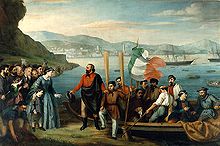
Garibaldi landed on May 11, 1860 - initially with Cavour's support - with a 1067-strong force of volunteers, also known as the Train of Thousands ("Spedizione dei Mille") , in Sicily , where he proclaimed himself dictator . At the Battle of Calatafimi , his army defeated the troops of the King of Naples. A popular uprising had a supportive effect on the capture of Palermo by Garibaldi's free group . Following the victories on the island, his army, which was also joined by many local insurgents from the underprivileged strata of the small farmers and agricultural workers during their advance, liberated the rest of the Kingdom of the Two Sicilies from the rule of the Spanish Bourbons on August 20, 1860. On September 7th, 1860, after the flight of the last Bourbon king Francis II , Garibaldi and his troops, the so-called red shirts , took the capital Naples.
Garibaldi's success jeopardized the leadership role of Sardinia-Piedmont in the unification of Italy. The liberal-conservative circles around Cavour feared a Neapolitan republic and, similar to the suppression of the Roman republic of 1849, new foreign interventions if Garibaldi should penetrate as far as Rome. Count Cavour agreed with Napoleon III. the approval of the conquest of belonging to the Papal States brands and Umbria , to forestall Garibaldi. In September 1860, Piedmontese troops entered the provinces of the Papal States. At Castelfidardo , near Ancona, the papal army was defeated (cf. Battle of Castelfidardo ); the remaining Papal States under French protection with Latium and its capital Rome remained untouched. After this victory, the Piedmontese troops under the command of King Victor Emmanuel II pushed further south until they united with Garibaldi's troop army.
Garibaldi resigned his claim to power after the population of both Sicilies, like those of northern Italy in March of the same year, in a plebiscite on October 21, 1860, voted with an overwhelming majority for annexation to the Kingdom of Sardinia-Piedmont. On October 26th, 1860, the legendary meeting between Victor Emanuel II and Garibaldi took place in Teano near Naples, at which the latter welcomed the Piedmontese monarch as "King of Italy". In March 1861, the new Italian monarchy under King Victor Emmanuel was finally proclaimed in Turin. Camillo Benso Count von Cavour became the first Prime Minister of Italy, when he remained in office for almost three months until his death on June 6, 1861. The previous Sardinian-Piedmontese capital Turin was the provisional seat of government. In 1864 this status changed to Florence , the capital of Tuscany.
The new Italy was ultimately enforced “from above”, even if the previous revolutions were supported by the people. The Republicans' hopes for a constituent national assembly were not fulfilled. Gradually, the Sardinian-Piedmontese constitution of 1848 was transferred to Italy, which established a constitutional monarchy. Political representation was limited to a small conservative-liberal upper class because of the high census suffrage with only 1.9% of the population entitled to vote. The right to vote was later expanded, but was still reserved for a minority. It was not until 1912 that almost universal suffrage was introduced in Italy. The progressive liberal parliamentarians Marco Minghetti and Luigi Carlo Farini failed with their plan to make autonomous regions the basis of the new Italy. Under Bettino Ricasoli , Cavour's successor, Italy received a centralized administration and, like France, was divided into provinces .
The major European powers France, Prussia ( Friedrich Wilhelm IV. ) And Great Britain ( Victoria ) recognized the new state of Italy. Protest against diplomatic recognition came from Austria and the Papal States, which rightly feared further claims by Italy to their sovereign territories or parts of them. Veneto in the northeast, which was still under the Habsburg rule of Austria (until 1866), as well as the remaining church state with Rome, in which French protection troops were stationed (until 1870) , did not initially belong to Italy .
Completion of the unity of Italy by 1870

In the wake of the escalation of the Austro-Prussian conflict, Italy concluded an alliance with Prussia on April 8, 1866 . The aim was to weaken Austria and also to connect Veneto to Italy. A few days after the start of the German War between Prussia and Austria on June 14, 1866, Italy also declared war on Austria ( Third Italian War of Independence ). Austria, for its part, had promised France to Veneto in a secret treaty on June 12th .
Although Austria won the battles in Italy (battle of Custoza on June 24, 1866, sea battle of Lissa on July 20, 1866), the empire under Franz Joseph I lost the war against Prussia in the decisive battle at Königgrätz on July 3, 1866 This defeat meant that Veneto was ceded to Italy a day later. Austria would have had to give up its rule over northern Italy even in the event of a victory over Prussia, because then, according to a Franco-Austrian secret agreement of June 12, 1866, these areas would fall to France. The separation of the Lombardy-Venetian kingdom from the Austrian monarchy was agreed in the preliminary peace of Nikolsburg on July 26, 1866 and became binding with the Peace of Prague on August 23, 1866. France passed these territories on to the Kingdom of Italy . Italian troops were able to invade Veneto without a fight. In the Peace of Vienna between Italy and Austria on October 3, 1866, Veneto was confirmed as Italian possession; on October 19, 1866 it was formally annexed. Nevertheless, after 1866 some areas claimed by Italy remained in Austrian hands: the Terre irredente ("unredeemed areas"). They fell to Italy after the First World War .

Also the remaining church state under Pope Pius IX. remained a source of conflict. As early as the 1830s, the demand for secular rule had been made. Rome was considered the natural capital of Italy by the Italian nationalists. In October 1867 Garibaldi, who after his temporary withdrawal from politics had returned to the active politico-militant "stage", tried with a few troops to take Rome again. However, his units were defeated on November 3, 1867 by French and papal troops at Mentana . As early as 1862, his first attempt at Aspromonte had failed.
When the war between France and Prussia broke out on July 19, 1870, Italy was convenient on the question of the Papal States. When France withdrew its protection troops from Rome because of the war, Italian troops conquered the Papal States on September 11, 1870, without encountering significant resistance. On September 20, 1870 Rome was taken (so-called "Breccia di Porta Pia ").
A referendum - the last of a total of ten corresponding plebiscites in the individual regions of Italy over the course of ten years - resulted in broad support for the unification of the Papal States with Italy. The association was proclaimed by royal decree on October 6, 1870 . Thus the unification of Italy and with it the aim of the Risorgimento was completed. In 1871 the Italian capital was moved from Florence to Rome. Most foreign states also moved their embassies to Rome, thereby tacitly recognizing the end of the secular rule of the papacy.
The referendums in the years 1860 to 1870 on the connection to Sardinia-Piedmont or Italy in the individual regions had resulted in:
| area | Yes | No | date |
|---|---|---|---|
| Tuscany | 366,571 | 14,925 | 11./12. March 1860 |
| Emilia | 426.006 | 756 | 11./12. March 1860 |
| Nice | 25,743 | 160 | April 15, 1860 |
| Savoy | 130,533 | 237 | April 22, 1860 |
| Naples | 1,302,064 | 10,312 | October 21, 1860 |
| Sicily | 432.053 | 667 | October 21, 1860 |
| Brands | 133,807 | 1,212 | 4th / 5th November 1860 |
| Umbria | 97.040 | 380 | 4th / 5th November 1860 |
| Venice, Mantua | 647.246 | 69 | 21./22. October 1866 |
| Rome, provinces | 133,681 | 1,507 | October 2, 1870 |
Further development after 1870
Roman question, church conflict
The Pope continued to have his seat in the Vatican . In the so-called guarantee laws of May 1871, his position in the Italian capital was regulated, albeit initially only unilaterally from the Italian government. Accordingly, the Vatican, the Lateran and the papal summer residence in Castel Gandolfo remained under the sovereignty of the Pope, who is considered sovereign in these areas to the present day .

Pius IX (Pope from 1846 to 1878) and his immediate successor Leo XIII. and Pius X , however, neither recognized the legal regulations for the Vatican nor the new Italy and rejected all official diplomatic cooperation with the new rulers. The dispute over the status of the Catholic Church and the independent state independence of the Vatican, which was initially not formally regulated, remained a conflict that simmered for a long time even after the completion of Italian unity (so-called Roman question ). Pius IX considered himself a "prisoner in the Vatican" . He banned the authors and participants in the taking of the Papal States . As early as 1864 he had condemned fundamental principles of political liberalism in the encyclical Quanta Cura and the syllabus errorum attached to it . This had exacerbated the conflict between the Roman Catholic Church and the secularization efforts of liberalism and took on European dimensions in the following two decades. The pontificate of Pius X. (Pope from 1903 to 1914) is considered the high phase of anti-modernism . Ultramontanism also prevailed in many regional churches (roughly translated, Pope submission; cf. also Kulturkampf in Germany).
In the papal bull Non expedit of September 10, 1874 Pius IX forbade. Italian Catholics active and passive participation in democratic elections in Italy. His demand for restoration of the secular power of the papacy remained unsuccessful, however - despite the continued ecclesiastical supremacy with global and political influence, which has been increasing since the proclamation of the papal “ infallibility ” after the first Vatican council on July 18, 1870. Wide Catholic classes remained alienated by the capture of Rome. It was not until the Lateran Treaty concluded in 1929 between Pope Pius XI. and from October 1922 the fascist Italian government under Benito Mussolini , in which the Holy See recognized Rome as the capital of Italy and seat of the Italian government, the political and state sovereignty of the Vatican was guaranteed by Italy.
North-South conflict, labor movement
In the social and economic area, the conflict between the richer, industrialized north of Italy and the agriculturally poor south of the country ( Mezzogiorno ) continues - right up to the separatist efforts of the politically right-wing populist Northern Italian Lega Nord led by Umberto Bossi on the transition from 20th to 21st centuries. Century.
After the proclamation of the Kingdom of Italy in 1861, the hopes of the southern Italian smallholders and farm workers for a redistribution of large estates were dashed. Indirect taxes added to their poverty. The free trade between the Italian regions introduced after the establishment of the state created a competitive pressure which the south could not withstand and which hindered the region's economic development. The lack of socio-political changes made the still young Italian labor movement , which had been influenced by Giuseppe Mazzini, the radical democratic mastermind of the Risorgimento, increasingly dissatisfied with the political practice of the Italian monarchy. Mazzini himself, who had to act out of exile for most of his politically active time, stood as a resolute representative of a republican democracy in the intellectual conflict between republicanism and socialism not only in Italian but also in pan-European terms at the beginning of the 1870s - at the end of his Life - increasingly isolated between the progressive poles of the ideological disputes of this time.

Under the influence of the Russian anarchist Mikhail Bakunin , which had grown stronger since the mid-1860s, part of the former Mazzini supporters, including Giuseppe Garibaldi , turned - starting from southern Italy, where Bakunin had founded the "Fraternité Internationale" (international brotherhood) group belonged to the fundamentally anti-state and social-revolutionary anarchism . This dominated - at the latest after the split in the International Workers 'Association (see also International ) in 1872, which was divided into Marxists and Bakuninists - more than in Northern and Central Europe the socialist workers' movement in Italy up to the beginning of the 20th century. The anarchist movement fought - after Bakunin's death under the formative influence of the activist Errico Malatesta - the Italian state all the more, as the economic and internal political contradictions in the Italian state became clearer after the national enthusiasm had waned following the establishment of the state. A socialist party influenced by Marxism , the Partito Socialista Italiano , in which syndicalist influences represented by some anarchists initially formed a strong wing, was only founded in 1892. This was after industrialization had advanced in northern Italy and a politically relevant - above all urban - industrial proletariat had formed there.

The south of Italy remained a smoldering trouble spot for a long time as a result of the social hardship. The Fasci Siciliani , a socialist- oriented popular movement in Sicily , was founded in 1891 and put down in 1894 after tough military operations under the leadership of Prime Minister Crispi . In addition, there was a pronounced bandit system ( brigandism ) , often against the big landowners , which was supported by the Spanish Bourbons, who had since been disempowered, and which bound large parts of the Italian army internally even after the founding of the state of Italy. Carmine Crocco (a kind of Italian Robin Hood ) was a legendary leader of the Social Revolutionary Briganti , which increasingly impoverished peasants and farm laborers had joined from the 1860s . At times he controlled over 40 gangs who, as guerrilla units, had also supported Giuseppe Garibaldi's irregulars.
The increasing impoverishment of southern Italy also led to a long-lasting emigration of large parts of the population to northern Italy and to increased economically motivated emigration , often to the USA or South America.
Irredentism, imperialism, right-wing movements
In 1877 Matteo Renato Imbriani-Poerio founded the organization Italia Irredenta ("Unredeemed Italy"). She called for the connection of Trentino , Trieste , Friuli and Istria to Italy. This association quickly spread in right-wing nationalist circles, which became stronger under King Umberto I from 1878 onwards. Under his rule, especially during the reign of the authoritarian Prime Minister Francesco Crispi between 1887 and 1896, Italy developed into an imperialist state that extended its sphere of influence to East Africa and in 1890 constituted the colony of Eritrea . When trying to expand the area of influence in Africa to the southeast, Italy acted unsuccessfully in the colonial war of 1895/96 and was defeated by the troops of Emperor Menelik II of Ethiopia in the Battle of Adua , whereupon Crispi had to resign. However, Eritrea itself remained under Italian sovereignty until 1941.
Due to the lack of success in East Africa, Italy renewed at the beginning of the 20th century, after the assassination of King Umberto I by an anarchist assassin (1900), now under the reign of Victor Emmanuel III. , his community of interests with France through various secret agreements. As a result, Libyan Tripoli , which was then under Ottoman rule, came under the influence of Italy, while Morocco was left to France. In 1911 Italy annexed Tripoli and Cyrenaica . This occupation led to the conflict with the Ottoman Empire and the Italo-Turkish War of 1911/12, as a result of which Italy gained some Mediterranean islands, including Rhodes in the Aegean Sea .
In 1910, a right-wing extremist nationalist party was founded with the Associazione Nazionalista Italiana , which was absorbed by Benito Mussolini's fascist organization until 1923 . In the course of the high industrialization of Northern Italy in the run-up to the First World War, this party tried to absorb the increasing social differences with nationalist slogans, called for an expansionist foreign policy in the spirit of imperialism and renewed the ideas of the irredentists. It was supported in particular by large-scale industry.
Most of the Italian-speaking areas of northern Italy that still belong to Austria-Hungary (the Trentino and the regions of Dalmatia and Istria , which are largely inhabited by Croatians ), the so-called terre irredente , did not fall until after Austria's defeat in the First World War by the Treaty of Saint-Germain of September 10, 1919 to Italy, as well as the mainly German-speaking South Tyrol . These areas had already been assigned to Italy in 1915 during the secret negotiations between France, Great Britain, Russia and Italy that had led to the London Treaty . Under the terms of this treaty, Italy then left the Triple Alliance with Austria, Germany and Romania and took part on the side of the Entente in the First World War against what was then Austria-Hungary.
In order to change the demographic structure in favor of the Italian-speaking population group, from 1922, after the fascists under Benito Mussolini came to power, more Italians were settled and the native languages that had prevailed regionally up to that point ( German in South Tyrol, Croatian and Slovenian in Istria, Croatian in Dalmatia) and the respective cultural peculiarities are sometimes massively suppressed (cf. Italianization ).
Cultural aspects
A problem of the formation of the Italian nation state that ran through the entire epoch of the Risorgimento was the cultural differences between the various regions of the Apennine peninsula, which were due not least to the lack of a uniform language . At the time the state was founded in the 1860s, the country was linguistically fragmented. In the different regions very different dialects (or independent languages depending on the definition) were spoken, which made it difficult to communicate across regions and thus also to develop national awareness on a cultural basis. The written Italian language was only spoken in its spoken form by around 2 to 2.5% of the population, and it was widely used in the educated circles of the privileged bourgeoisie. The majority of the population used different dialects, which differed more or less strongly from the written language. Incidentally, of the approximately 25 million Italians at the time, between 74 and 78% were illiterate .
In order to develop a national identity, however, the liberal-conservative circles (the historical right ), who formed the parliamentary majority between 1861 and 1876 due to the restricted census voting rights , considered a common language for all citizens to be a prerequisite. According to these ideas, the Italian language, based on the standard language developed in the Florentine Accademia della Crusca since the 16th century , should not only be the official language , but also the language of the people . The programmatic and pathetic exclamation of the conservative politician Massimo d'Azeglio at the first session of the all-Italian parliament was characteristic of such a claim :
- “We created Italy, now we have to create Italians!” (Quoted from: Eric Hobsbawm : Nations und Nationalismus , Bonn 2005; p. 58)
Basically Italian was a language of education , which, like all Romance languages from the Latin had developed and the first time of Dante Alighieri in the early 14th century as Volgare Illustre in the literature has been expressed. In later centuries it was further developed by other writers and developed particularly strongly in Florence , the capital of Tuscany. With the poets of the Risorgimento, especially Antonio Cesari , a representative of literary purismo ( loosely translated:… literary purity ), Alighieri and his pupil Giovanni Boccaccio took on historically derived, nationalist identity-forming functions.
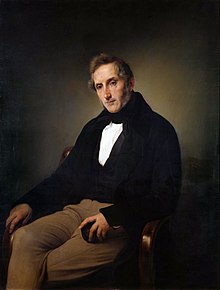
Others, who in the first half of the 19th century were shaped by the cultural epoch of Romanticism , which essentially originated in the German-speaking area , advocated spreading a common Italian language among the people, with the people's perspective being the decisive basis of poetry and Journalism should form. For the Italian literature of the 19th century, which played an important role in the formation of Italian identity in the national unification process, especially on the linguistic and cultural level, the poet Giacomo Leopardi was important, who with his poems in the 1820s spread an Italian patriotism . The novelist Alessandro Manzoni achieved even greater impact in this context with his historical novel " I Promessi Sposi " (The Fiancee) , published in 1826 . It was also Manzoni who inspired many other writers and poets in the following decades.
In the field of music , the composer Giuseppe Verdi, with his famous operas based on the epic-romantic style of the French writer Victor Hugo , played a hardly less prominent role in establishing an Italian national consciousness. Many Italians - and not just Italians - consider Verdi to be the ultimate artist of the Risorgimento.
Nonetheless, the development of a uniform language spoken and understood by all Italian citizens remained a basic cultural and educational policy problem that existed well into the 20th century and which only eased with the spread of the mass media .
literature
- Wolfgang Altgeld (Hrsg.): Little Italian history. Reclam, Stuttgart 2001, ISBN 3-15-017036-2 .
- Anne Bruch : Italy on the way to becoming a nation-state - Giuseppe Ferrari's ideas of a federal-democratic order. Contributions to German and European history. Vol. 33. Reinhold Krämer, Hamburg 2005, ISBN 3-89622-077-2 .
- Giorgio Candeloro : Storia dell'Italia moderna , Vol. 3: La Rivoluzione nazionale, 1846–1849, 2nd edition, Milan 1991.
- Carlo Cardia, Risorgimento e religione, Giappichelli, Torino, 2011, ISBN 978-88-348-2552-5 .
- Nicola Guerra: Aracne (ed.): Controrisorgimento. Il movimento filoestense apuano e lunigianese 2009, ISBN 9788890416804 .
- Nicola Guerra: Le due anime del processo di unificazione nazionale: Risorgimento e Controrisorgimento. La necessità di un nuovo approccio di ricerca ancora disatteso . In: Chronica Mundi . October 2011, ISSN 2239-7515 , pp. 53-68.
- Ricarda Huch : People and Fates from the Risorgimento . Insel, Leipzig 1908, 1918, 1978.
- Eugen Lemberg : History of Nationalism in Europe. Schwab, Stuttgart 1950.
- Rudolf Lill : History of Italy in Modern Times. Scientific Book Society, Darmstadt 1998, ISBN 3-534-80014-1 .
- Denis Mack Smith: Il Risorgimento Italiano. Storia e testi . Bari, Laterza 1999.
- S. Marinelli, G. Mazzariol , F. Mazzocca (Eds.): Il veneto e l'Austria. Milan 1989.
- Marco Meriggi: Social Classes, Institutions and Nationalization in Liberal Italy. In: History and Society. Göttingen 2000,2, pp. 201-218. ISSN 0340-613X
- Volker Reinhardt : History of Italy from late antiquity to the present. CH Beck, Munich 2003. ISBN 3-406-50284-9 .
- Jörn Leonhard : Initial or model? The perception of the Italian Risorgimento in Germany since 1850 ( PDF ), in: Yearbook on Liberalism Research. 17th year 2005, Nomos Verlagsgesellschaft, Baden-Baden 2005 (pp. 199–214), ISBN 3-8329-1494-3 .
- Gian Enrico Rusconi: Cavour and Bismarck. The way to German and Italian unification in the field of tension between liberalism and Caesarism. Oldenbourg 2013, ISBN 978-3-486-71533-0 .
- Gustav Seibt : Rome or Death. The fight for the Italian capital. Berlin 2001, ISBN 3-88680-726-6 .
- Eugen Semrau: Austria's footsteps in Venice. With contributions by Antonio A. Rizzoli and Miguel Herz-Kestranek. Styria, Vienna / Graz / Klagenfurt 2010, ISBN 978-3-222-13309-1 .
- Alvise Zorzi : Austria's Venice. The last chapter of foreign rule 1798 to 1866. Translated from the Italian by Heinz-Georg Held and Claudia Piras. Claasen, Düsseldorf 1990, ISBN 3-546-49970-0 . (Original under the title Venezia Austriaca. Laterza, Rom, Bari 1985, ISBN 88-420-2650-6 ).
- Stefan Heid , Karl-Joseph Hummel (ed.): Papality and patriotism. The Campo Santo Teutonico: Place of the Germans in Rome between Risorgimento and the First World War (1870–1918) (= Roman quarterly for Christian antiquity and church history . Supplement vol. 65). Herder, Freiburg (Breisgau) et al. 2018, ISBN 978-3-451-38130-0 .
Novel and film
- Giuseppe Tomasi di Lampedusa : The Leopard ( Il Gattopardo ). Piper-Verlag, Munich 1959, new 2004, new 2019 (novel from 1957 about the decline of the Sicilian landed nobility at the time of the Garibaldi campaign and the subsequent founding of the Italian state in 1860/61)
- The leopard . Italy / France 1963. Director: Luchino Visconti (film adaptation of the novel of the same name)
Web links
- Detailed introduction to the history of the Risorgimento by Werner Daum, based on the modern internal Italian debate about the secessionist efforts of the Lega Nord around Umberto Bossi; including further links to literature u. a.
- Presentation on the Risorgimento ( Memento from June 30, 2007 in the Internet Archive )
- Risorgimento In: Encyclopedia of 1848 Revolutions (English)
- Risorgimento themed portal on historicum.net
Remarks
- ^ Volker Reinhardt : History of Italy. CH Beck, Munich 1999, p. 100.
- ^ Alvise Zorzi: Austria's Venice. Düsseldorf / Hildesheim 1990 p. 229 f.
- ↑ Pascal Oswald: From Volturno to Mentana: Giuseppe Garibaldi and the 'Roman Question'. In: risorgimento.info (accessed March 6, 2020).
- ↑ www.comune.roma.it
- ↑ According to: Jörg Fisch : The right of peoples to self-determination or the domestication of an illusion. Beck, Munich 2010, p. 125, "Table 3: The plebiscites in connection with the Italian unification, 1860-1870".

